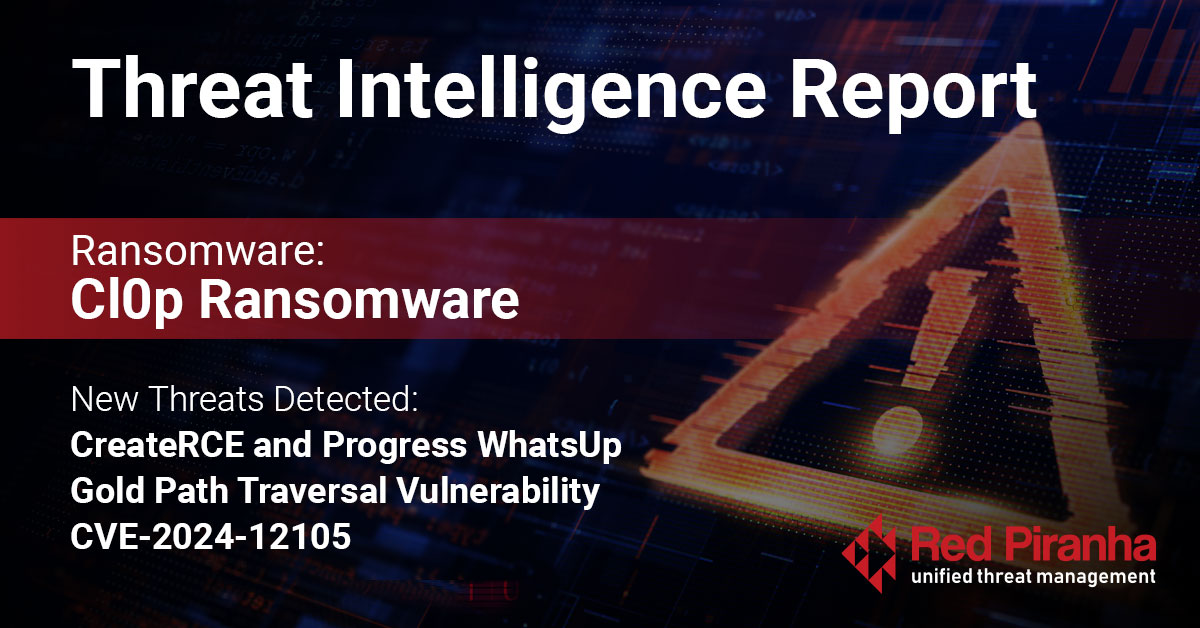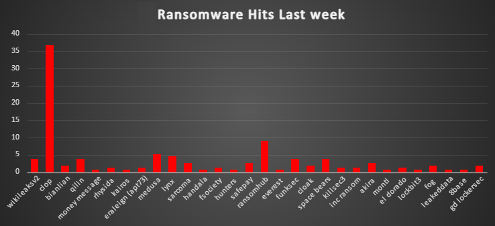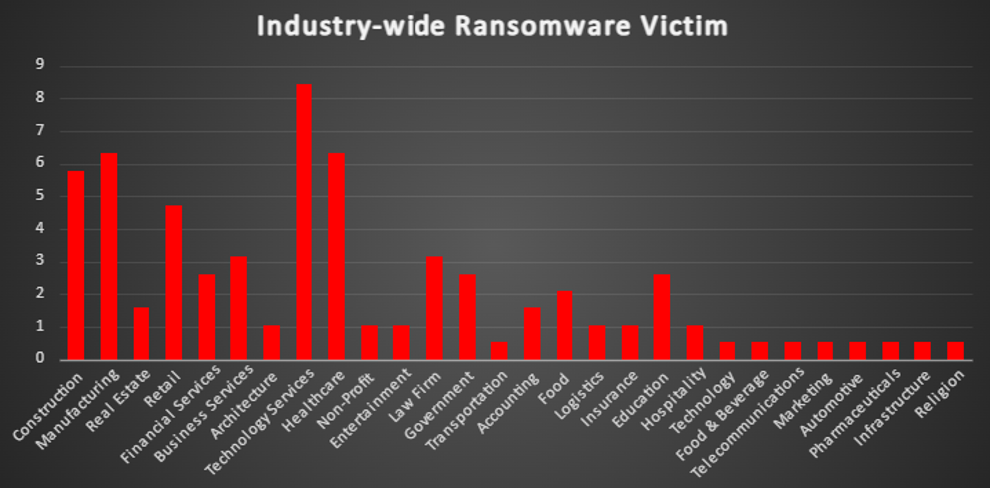
| New Threat Detection Added | 2 - CreateRCE and Progress WhatsUp Gold Path Traversal Vulnerability CVE-2024-12105 |
| New Threat Protections | 313 |
Weekly Detected Threats
The following threats were added to Crystal Eye this week:
Threat name: | CreateRCE | ||||||||||||||||||
A critical vulnerability in Microsoft Windows, designated as CVE-2023-35628 has been identified. This flaw resides in the CreateUri function, which is responsible for parsing Uniform Resource Identifiers (URIs). An attacker can exploit this vulnerability by sending a specially crafted email to an Outlook client or by persuading a user to navigate to a folder containing a malicious file in File Explorer. Successful exploitation allows for remote code execution without user interaction, making it a zero-click vulnerability. Microsoft addressed this issue in the December 2023 Patch Tuesday update. Systems updated with this patch are protected against this vulnerability. | |||||||||||||||||||
Threat Protected: | 01 | ||||||||||||||||||
Rule Set Type: |
| ||||||||||||||||||
Class Type: | Trojan-activity | ||||||||||||||||||
Kill Chain: |
| ||||||||||||||||||
Threat name: | Progress WhatsUp Gold Path Traversal Vulnerability CVE-2024-12105 | ||||||||||||||||||
A path traversal vulnerability, identified as CVE-2024-12105, has been discovered in Progress WhatsUp Gold version 24.0.1 Build 2177, Total Plus Edition. This vulnerability exists in the handling of SnmpExtendedActiveMonitor requests. An authenticated attacker can exploit this flaw by sending a specially crafted HTTP request, leading to unauthorised information disclosure. The issue arises from improper validation of user-supplied input, allowing attackers to access files and directories outside the intended directory structure. | |||||||||||||||||||
Threat Protected: | 01 | ||||||||||||||||||
Rule Set Type: |
| ||||||||||||||||||
Class Type: | Attempted-admin | ||||||||||||||||||
Kill Chain: |
| ||||||||||||||||||
Known Exploited Vulnerabilities (Week 4 - January 2025)
For more information, please visit the Red Piranha Forum:
https://forum.redpiranha.net/t/known-exploited-vulnerabilities-catalog-4th-week-of-january-2025/540
Vulnerability | CVSS | Description | |
CVE-2020-11023 | 6.1 (Medium) | JQuery Cross-Site Scripting (XSS) Vulnerability | |
CVE-2025-23006 | 9.8 (Critical) | SonicWall SMA1000 Appliances Deserialisation Vulnerability |
Updated Malware Signatures (Week 4 - January 2025)
Threat | Description | |
Lumma Stealer | A type of malware classified as an information stealer. Its primary purpose is to steal sensitive information from infected systems, including but not limited to credentials, financial information, browser data, and potentially other personal or confidential information. | |
Mirai | A malware that turns networked devices running out-of-date Linux-based firmware—such as routers, IP cameras, and other Internet of Things (IoT) devices—into remotely controlled bots. These bots are then used as part of a botnet in large-scale Distributed Denial of Service (DDoS) attacks. | |
Tofsee | A malware that is used to send spam emails, conduct click frauds as well as crypto mining. | |
Upatre | Upatre is also a malware dropper that downloads additional malware on an infected machine. It is usually observed to drop banking trojan after the initial infection. |
| Ransomware Report | |
The Red Piranha Team conducts ongoing surveillance of the dark web and other channels to identify global organisations impacted by ransomware attacks. From January 18th January to 24th, 2024, our monitoring revealed multiple ransomware incidents across diverse threat groups, underscoring the persistent and widespread nature of these cyber risks. Presented below is a detailed breakdown of ransomware group activities during this period. | |
| Name of Ransomware Group | Overall %age of total attack coverage |
Wikileaksv2 | 3.87% |
36.77% | |
Bianlian | 1.94% |
Qilin | 3.87% |
Money message | 0.65% |
1.29% | |
Kairos | 0.65% |
Eraleign (apt73) | 1.29% |
5.16% | |
Lynx | 4.52% |
Sarcoma | 2.58% |
Handala | 0.65% |
Fsociety | 1.29% |
Hunters | 0.65% |
2.58% | |
RansomHub | 9.03% |
Everest | 0.65% |
FunkSec | 3.87% |
Cloak | 1.94% |
Space Bears | 3.87% |
Killsec3 | 1.29% |
Inc ransom | 1.29% |
Akira | 2.58% |
Monti | 0.65% |
El Dorado | 1.29% |
0.65% | |
1.94% | |
Leaked Data | 0.65% |
8base | 0.65% |
GD LockerSec | 1.94% |

Cl0p Ransomware
Overview
Cl0p ransomware has emerged as one of the most persistent and financially damaging cyber threats in recent years. Known for targeting organisations in a variety of industries—most notably finance and government - Cl0p leverages a combination of advanced exploitation techniques and sophisticated encryption methods to extort its victims. The ransomware is infamous for its “double extortion” model: encrypting a victim’s files while also threatening to leak sensitive data if a ransom isn’t paid. By adapting to new vulnerabilities, Cl0p remains a dynamic and dangerous adversary.
Detailed TTPs (Tactics, Techniques, and Procedures)
- Exploiting publicly known vulnerabilities in widely used software.
- Phishing campaigns using targeted social engineering.
- Leveraging malicious dropper files that execute PowerShell scripts.
- Executing unsigned binaries to establish persistence.
- Maintaining access through encrypted backdoors and custom malware strains.
- Using stolen credentials to re-enter compromised networks.
- Identifying and exploiting configuration flaws or weak permissions.
- Abusing legitimate administrative tools to escalate access.
- Stealing sensitive data before encryption (double extortion).
- Encrypting files with advanced cryptographic algorithms.
- Rendering critical systems and data inaccessible.
- Threatening reputational harm by leaking stolen data.
MITRE ATT&CK ID | Technique |
T1082 | System Information Discovery |
T1190 | Exploit Public-Facing Application |
T1083 | File and Directory Discovery |
T1204 | User Execution |
T1059.001 | PowerShell |
T1566 | Phishing |
T1027 | Obfuscated Files or Information |
T1486 | Data Encrypted for Impact |
T1573 | Encrypted Channel |
T1105 | Ingress Tool Transfer |
T1490 | Inhibit System Recovery |
Ransomware Note:
IOCs (Indicators of Compromise)
- CVE-2023-0669
- CVE-2023-34362
- CVE-2024-45195
- CVE-2024-50623
- CVE-2024-55956
- 103.140.62.43
- 146.190.133.67
- 162.240.110.250
File Extensions:
- .cl0p (renamed encrypted files)
- Files encrypted with RC4, RSA-1024 wrapping the encryption keys.
- Obfuscated payloads and scripts to evade detection.
Mitigations
- Apply Security Patches Promptly:
- Regularly update software, particularly those known to have been exploited by Cl0p (e.g., file transfer solutions).
- Implement a Strong Backup Strategy:
- Maintain offline or immutable backups of critical data.
- Regularly test backups to ensure they are accessible and complete.
- Enhance Network Segmentation and Access Control:
- Segregate sensitive data and systems from regular user access.
- Apply the principle of least privilege (PoLP).
- Conduct Regular Security Awareness Training:
- Educate employees about phishing attacks and social engineering techniques.
- Emphasise the importance of scrutinising unsolicited emails and links.
- Deploy Advanced Threat Detection and Response Solutions:
- Use Endpoint Detection and Response (EDR) to identify suspicious behaviour early.
- Monitor network traffic for signs of data exfiltration or unauthorised encryption attempts.
- Establish a Clear Incident Response Plan:
- Define roles and responsibilities for responding to ransomware attacks.
- Conduct tabletop exercises to prepare for a rapid response.
By employing these proactive measures, organisations can significantly reduce the risk of Cl0p ransomware infections and minimise the impact of an attack.
Ransomware Victims Worldwide
A recent ransomware analysis reveals that the United States remains the most heavily impacted nation, accounting for a staggering 56.77% of global incidents—underscoring its continued vulnerability to ransomware threats. Canada follows with 8.39% of recorded attacks, highlighting significant challenges in North America. Meanwhile, Australia, the United Kingdom, and India contribute 5.81%, 3.87%, and 3.87% of global incidents respectively, reflecting ongoing risks in both Asia-Pacific and Europe.
Other countries such as France (1.29%), Germany (2.58%), Pakistan (2.58%), and Italy (1.29%) also show notable levels of ransomware activity. The Netherlands, Mexico, and Bangladesh each recorded 1.94% of global incidents, signalling the broad geographic spread of ransomware threats.
Lower but still notable percentages come from nations like Vietnam, Kuwait, and Denmark, which contribute 0.65% each. Countries including Israel, Switzerland, Malaysia, Portugal, Philippines, Japan, and Morocco also reflect small yet significant parts of the worldwide ransomware landscape.
This distribution illustrates the global and persistent nature of ransomware threats, with North America continuing to bear the brunt of attacks. The findings further emphasise the critical need for strengthened cybersecurity measures, proactive defence strategies, and heightened vigilance across all sectors to counter the unrelenting rise in ransomware incidents worldwide.

Ransomware Victims Industry-wide
A recent ransomware analysis reveals Manufacturing as the most targeted sector, accounting for 26.96% of the total reported incidents. Next in line is Retail at 20.87%, followed by IT and Business Services, each at 13.04%. The Transportation sector stands at 11.3%, illustrating the widespread nature of ransomware threats across multiple key industries.
Healthcare reported 6.96% of attacks, while Education recorded 6.09%. Construction showed 9.57%, underscoring the persistent risk levels across these industries. Finance reported 7.83%, highlighting consistent exposure within the financial arena.
Further down the list, Hospitality and Telecommunications each contributed 1.74% of incidents. Federal entities, Energy, and Consumer Services recorded 4.35%, 4.35%, and 0.87% respectively. Real Estate and Law Firms also reported smaller percentages of ransomware attacks, showing that no sector is immune.
This analysis underscores the pervasive and indiscriminate nature of ransomware, cutting across critical infrastructure, public services, and commercial enterprises alike. Organisations must adopt robust cybersecurity frameworks, invest in proactive threat detection, and develop effective incident response strategies to mitigate the evolving ransomware landscape effectively.

